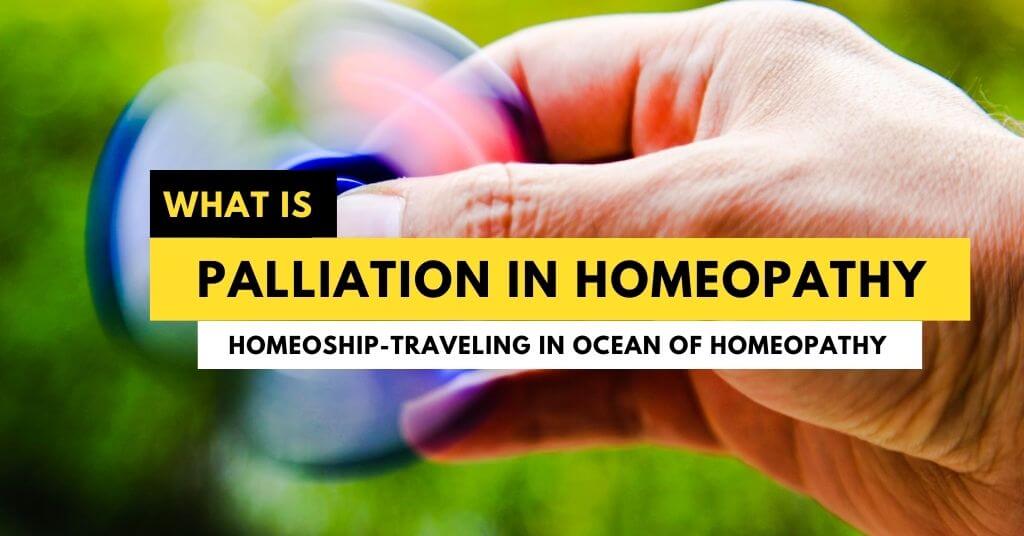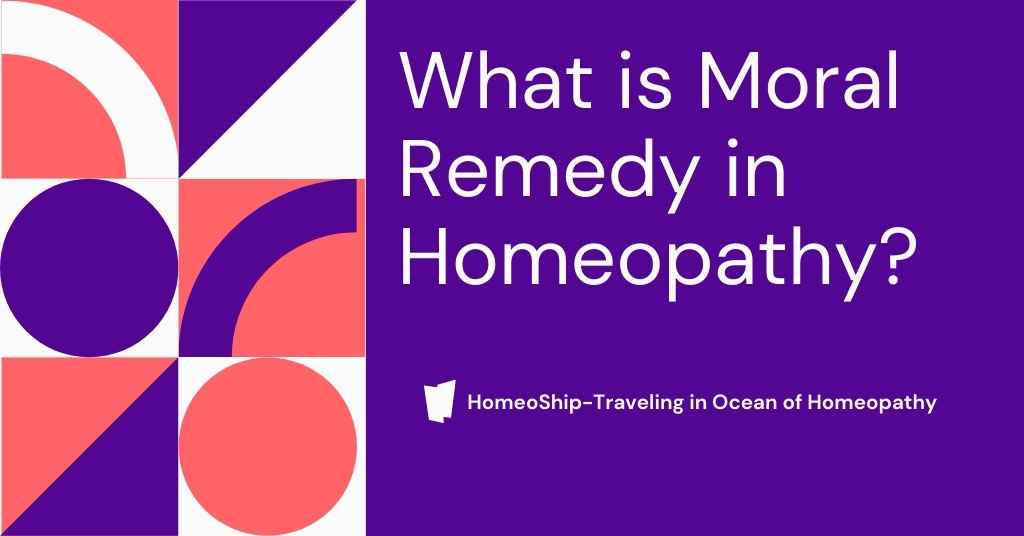Contents
The word palliation you are hearing among homoeopath, do you wonder why it is so much used and what it convey to us, and why pollution is not good for the ideal cure
It generally means easing the severity of pain or disease without removing the cause which is not in the favor of the ideal cure. It can be defined as temporary relief of symptoms without doing anything for the cure. In palliation, the most annoying symptoms are relieved, and the disease persists in its place, but the patient stops to experience them for a shorter term.

Palliation in Homeopathy
The word palliation (PA-lee-AY-shun) simply means to relieve, alleviate or ease the complaint. It can be defined as temporary relief of the annoying symptoms of the disease to ease the distressed patient.
Let’s understand palliation with the help of the example:
In the case of diarrhoea (loose watery stools), which can lead to dehydration and more such complications if not treated well, in such case a medicine is prescribed which can produce constipation.
or
In the case of insomnia (difficulty in sleeping), which disturbs the patient and leads to decreased productivity, then a medicine is given that produces sleep (sedatives)
Homoeopathy is a curative medicine in curable natural miasmatic diseased conditions. The cure is possible only if the vital force is in a need to react to the similar and stronger medicine administered. With the help of similimum medicine, vital force tries to bring back the healthy functioning of the diseased organ thus restoring health. But there are certain conditions where the cure may not be possible as the organs affected are damaged or congenitally missing.
Condition in which palliation is allowed in homoeopathy
(According to the footnote to § 67)
Hahnemann explains the conditions where a homoeopath can make use of antipathic principles. Homoeopathy, as a rule, is a method intended to cure dynamic miasmatic conditions. Homoeopathic medicines, by producing the primary action upon the vital force, induce the secondary curative response.
In this process, the vital force takes a vital and active role in the production of secondary curative action. But there are certain conditions where the stimulation of vital force is either impossible or the vital force has lost the reactive capacity itself.
Examples: cases like asphyxia, problems due to lightning, suffocation, freezing or drowning, etc. In such conditions, homoeopathic medicines prove ineffective as the secondary curative response cannot be induced.
Hahnemann says, “only in the most urgent cases, where the danger to life and imminent death allow no time for the action of a homoeopathic remedy- not hours, sometimes not even quarter hours, and scarcely minutes”, it is admissible to apply palliative means.
Palliative procedures like gentle electrical shocks, clusters of strong coffee, a stimulating odour, the gradual application of heat, etc can be employed. Various antidotes in case of poisoning, like alkalies for mineral acids, Hepar sulphur for metallic poisons, coffee and Camphor for poisoning by Opium, etc also can be kept in this category.
This is admissible here because when sufficient stimulation is effected, the vital force regains its strength again. But there is a new sect of homoeopaths (Mongrel Sect = cross bread dog), which neither practice homoeopathy according to its fundamental principles nor treat the patient by other laws. This group of homeopaths does not try hard to find the similimum to the patient’s sufferings to cure them. Due to this, when an ill-selected remedy fails to cure the patient they directly blamed homoeopathy as unsuitable to such and such cases.
Then they directly administer the allopathic medicines. Selecting a homoeopathic remedy is a very laborious process. It demands sincerity and hard work on the physician’s part. The selected remedy must cover the entire totality of the patient’s symptoms in a similar manner. But these new sects of homeopaths, without giving much importance to the similarity of the symptoms prescribe the medications. Naturally, when the medicine fails to cure the patient, they blame homoeopathy and resort to allopathic remedies. This type of practice is neither profitable to the patient nor to the physician.
In short, we can say palliation is used in:
1. Incurable Cases
In incurable cases with gross tissue damage, where deep-acting constitutional remedies cannot be used and where permanent cure is not possible, only palliative homoeopathic remedies are recommended.
H.A. Robert says, “in incurable conditions, the administration of the similar remedy almost always ameliorates the situation, at least for three or four days, and usually for a long period. Then we may have a return of symptoms when the indicated remedy will be called into use again”. H.A.Roberts confidently summarizes, “in incurable cases or seemingly incurable cases, we must not put a limitation on the possibilities of the similimum remedy, for in many seemingly incurable conditions the similimum will so completely meet the situation as to obliterate the symptomatology of disease and the pathology, and will restore the patient to health.”
2. Cure cannot be achieved
In cases where the most vital parts of the body are lacking or are damaged like congenital atrophy of kidneys, some cases after the surgical removal of the organs, etc, palliation is the only possible method.
For example: In cases where the thyroid gland is removed either partially or in total because of any malignant conditions, a cure cannot be achieved, as the patient is lacking the organs to be stimulated.
The patient has to depend on palliative or supplementary medications throughout his life. In the case where the palliative remedy is recommended, the palliative homoeopathic remedy must also be selected based on the symptom similarity only.
Dr J.T. Kent says “the physician who applies the single remedy in the potentized form under the law of cure for any length of time will easily be convinced that there is no other way of palliation that holds out permanent hope for the patient.”
H.A. Robert says “the basis of cure is the fundamental law of similia. The law of similia is the fundamental law also in the palliation of incurable states”.
Hahnemann also allows the application of Antipathic measures, according to the footnote to aphorism 67, antipathic palliative measures like gentle electrical shocks, strong coffee, and the application of heat can be given to stimulate the irritability and sensitivity of the vital force.
- In the most urgent cases, where there is a danger to life and no time for the homoeopathic remedy to act.
- Sudden accidental cases result in a life-threatening state of the patient, for example, asphyxia, suspended animation from lightening, suffocation, freezing, drowning, etc.
- In acute poisoning cases.
Let’s understand in the hierarchy form,
Diseases of severe nature require immediate medication, or which are create life-threatening conditions
↓
Here we apply the palliative method of treatment, initially, the disease seems to be reduced, as the medicine is of the opposite nature
↓
But, the chances of the reappearance of the disease symptoms after the exhaustion of the medical/remedial effect
↓
Many times it is seen that not only does the condition returns but it becomes more serious than before
Must Read:
Now let’s discuss,
The Pros and Cons of Palliation, (Merits and De-merits of palliation)
Pros of Palliation
- In life-threatening conditions, some initial relief is possible by palliation.
De-merits of Palliation
- Palliation is not a curative process, it is an extremely faulty method. After initial relief, the disease recurs again either in
- The condition of the patient becomes worse after the initial relief of symptoms. To relieve the patient progressively increasing doses of drugs will be needed repeatedly.
- Repeated use of palliative remedies in progressive doses might lead to the production of artificial drugs or iatrogenic diseases.
- Palliation is a one-sided symptomatic treatment; only a few troubling symptoms are covered to relieve the patient. Removal of the symptoms in total is only a cure; hence palliation is an extremely unscientific treatment.
- Prolonged palliative treatment will aggravate the symptom at every step of repetition of the remedy.
Hope you understand Palliation in Homeopathy! if you have any doubt! you can always ask us in the comment below. Follow us on Instagram for more updates.



Some genuinely nice stuff on this internet site, I it.
I think the admin of this website is truly working hard in support of his web page,
for the reason that here every data is quality based data.
I am not sure where you are getting your information, but great topic.
I needs to spend some time learning more or understanding more.
Thanks for excellent information I was looking
for this info for my mission.
Thank you
I could not resist commenting. Well written!
Hello, everything is going fine here and ofcourse every one is
sharing information, that’s genuinely fine,
keep up writing.
Great post. I will be dealing with many of these issues as well..
I’m amazed, I must say. Seldom do I come across a blog that’s equally educative and interesting,
and without a doubt, you have hit the nail on the head.
The issue is an issue that too few folks are speaking intelligently about.
Now i’m very happy that I stumbled across this during my search for something regarding this.
Stay tuned with us, we will bring more such interesting topics for you.
Its like you read my mind! You appear to know a lot about this, like you wrote the book
in it or something. I think that you could do with a few pics to drive the message home a bit, but other than that, this
is excellent blog. A great read. I’ll definitely be back.
That’s so generous of you!!
Thanks for any other informative website. The place else could I am getting that kind of
info written in such a perfect means? I’ve a mission that I’m just now operating on, and I have been at the glance out for such info.
Thank you for your kind words.
There’s definitely a lot to find out about this topic.
I like all of the points you have made.
I read this piece of writing fully about the difference
of most recent and preceding technologies, it’s awesome article.
Thank you!!